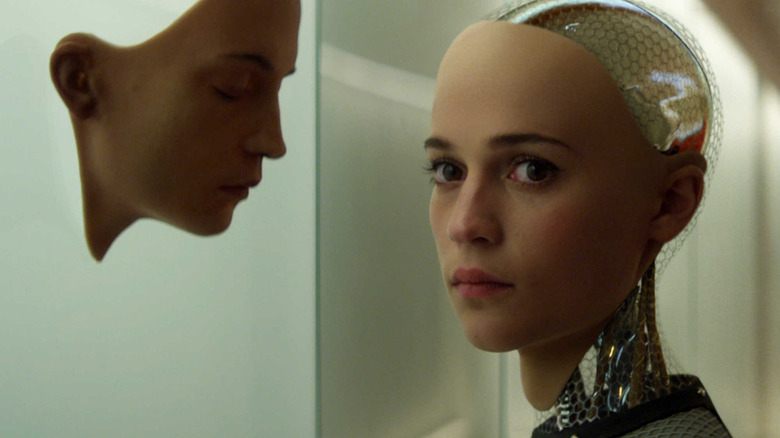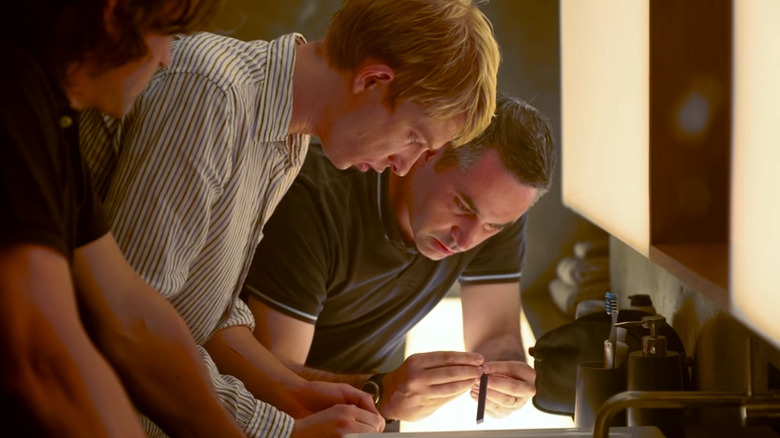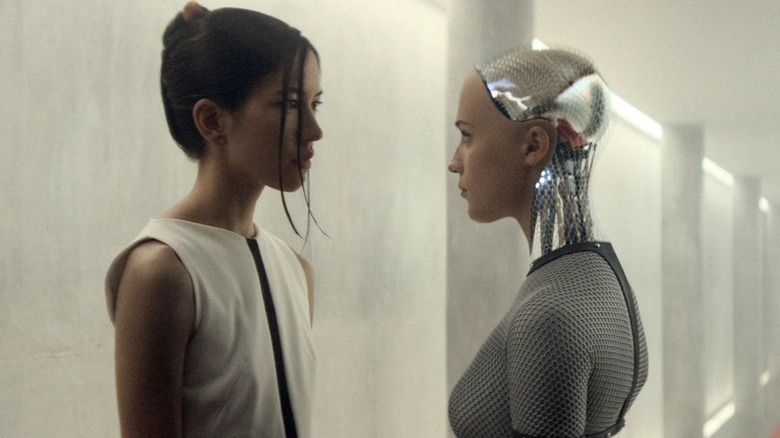Ex Machina's VFX Are Even More Impressive Considering They Didn't Use Any Green Screens
Alex Garland's "Ex Machina" is not only a distinguished achievement in sci-fi storytelling on a thematic level, but it reached technological excellence with its VFX on a low budget. Despite winning the Academy Award for Best Visual Effects in 2016, beating out "Star Wars: The Force Awakens," the A24-distributed film cost $15 million to shoot, edit, and complete. This was basically unheard of at the time, especially considering the fact that the film's star Alicia Vikander is a mostly computer-generated android that fully retains the emotional performance of the actress.
On a tight budget and crew size, "Ex Machina" shocked the world by proving that high-concept, small-budget filmmaking is here to stay. It did this while also revolutionizing the way stories about artificial intelligence are told through the lens of a humanized android. But the lack of funds typically afforded for major blockbusters meant the filmmaking crew had to get creative to pull off the reality-defying visuals. One of the most mind-boggling facts about the production is that the effortlessly convincing CGI in the film was crafted without the use of any green screens.
'We did away with green screen'
Despite the fact that nearly every frame that contains Ava (Vikander) requires extensive VFX, the filmmakers decided not to use green screens for logistical reasons. In an interview with TechRadar, VFX supervisor Andrew Whitehurst went on to reveal that "because Ex Machina was shot in such a short period of time (six weeks), we were shooting between 15 and 25 set-ups every day." Setting up and lighting green screen for every scene meant significantly adding to shooting time, an outcome the already tight production could not afford.
A reminder: the actress' face may be intact, but the rest of her body is digitally replaced by see-through skin and a metallic skeleton. This means those parts could've been aided by some bright green cloth in the VFX process, but time was of the essence. However, Whitehurst explains that there was another, more human reason for the decision:
"Secondly, because the film is made up of intimate scenes of dialogue between the characters, it was of the utmost importance that everyone on set could get into a groove, and it is my experience that as soon as you put a green screen up, everyone starts behaving a bit oddly. They just have this effect on cast and crew, so [to] keep the mood on set, we did away with green screen."
In a film where actors have to play androids that are on the verge of sentience, it does make sense to ensure the talent feels as comfortable as possible and not interrupted by a bright green screen.
It works because it's subtle
Although "Ex Machina" isn't the spectacle it competed against for its Academy Award, the way it utilizes special effects is arguably more exciting than many action-packed, CG-heavy films released in recent years. Instead of using visual effects to show chaos or destruction, Garland's work aims to show how the artificial intelligence in the film is becoming sentient. After working on bigger-scale films, Whitehurst had this to say to TechRadar:
"The blockbusters continue to get bigger and brasher, and people love them for it. So, massive films, with huge crews and stellar budgets, will continue for the foreseeable future. I think that's widely appreciated, though. What perhaps many cinema goers don't notice is that more lower budget, less spectacle-heavy films are making much greater use of VFX."
In "Ex Machina," robots don't go crazy and start attacking people — in fact, it's actually quite the opposite. Ava is trapped by her human maker, Nathan (Oscar Isaac), and it's her escape and interactions with Caleb (Domhnall Gleeson) that make her the most sympathetic of them all. No matter how you feel about that ending, the film is not afraid to subvert expectations and emotional connections.
If you haven't seen it yet, I implore you to do so. It's on the quickly-evaporating HBO Max streaming service, which features a plethora of A24 films in its library (for now, at least).


